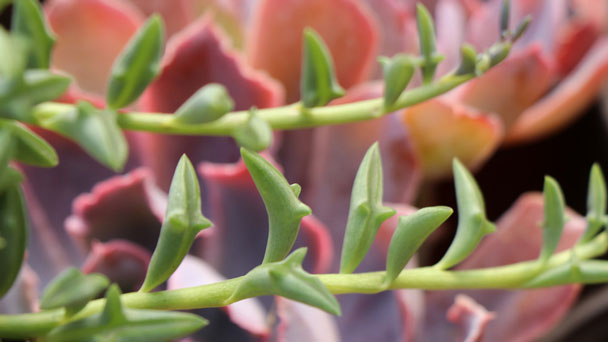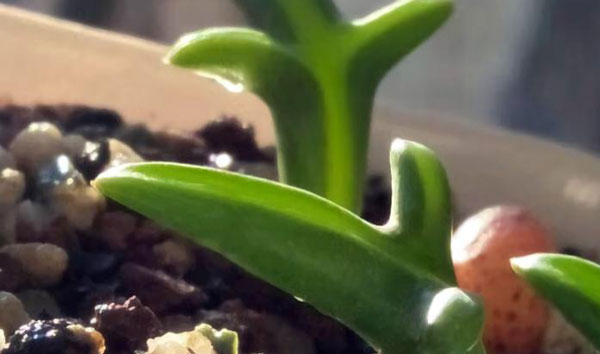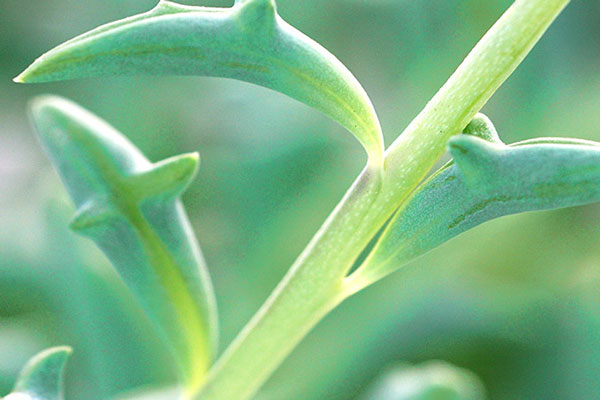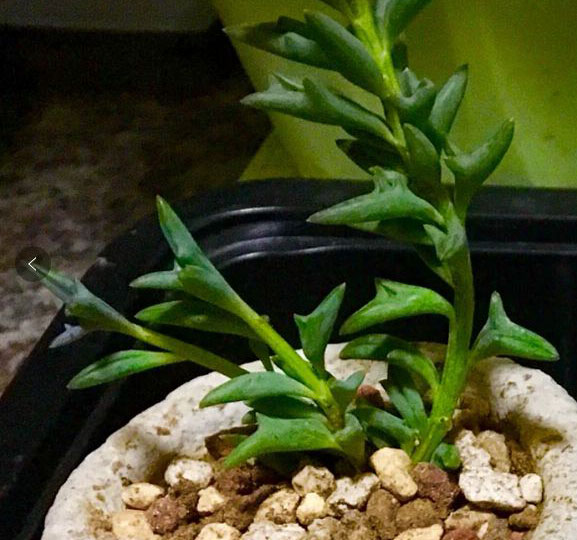String of Dolphins Plant (Senecio Peregrinus) Care & Propagation Guide
Written by Iris
Jan 08 2022

The botanical name String of Dolphins is Senecio Peregrinus. String of Dolphins is a beautiful succulent. True to its name, this trailing succulent has a series of fleshy leaves that look like little leaping dolphins. Because String of Dolphins plants is trailing succulents, they are well suited to hanging baskets. String of Dolphins plant is a relatively low-maintenance succulent, so caring for the String of Dolphins plant is relatively easy. (Find more best indoor hanging plants here.)

They require at least 6 hours of sunlight each day preferably by a sunny window with indirect light. We recommend picking a south-facing window. If you feel like your String of Dolphins (Senecio peregrinus) won't get enough sun during the winters, go ahead and place your String of Dolphins plants under T-5 fluorescent grow lights or LED grow lights.
Read More:
How Much Light Does String of Dolphins Need?
Read More:
How To Save My Overwatered String Of Dolphins?
Read More:
Why Are My String Of Dolphins Dying?
Hydrate the String of Dolphins plant 24hrs before tinkering with the roots to prevent the risk of transplant shock. For those situated in a darker location, introduce an extra amount of perlite and grit into the deeper portion of the pot to downplay over-watering risks.
Read Next:
String Of Bananas VS String Of Dolphins
String of Turtles Plant (Peperomia Prostrata) Care Guide
String of Pearls Plant Care & Propagation
String of Hearts Plant Care & Propagation
String of Rubies (Ruby Necklace Plant) Care & Propagation
20 Popular Vine Plants Indoor To Grow
11 Best String of Succulent Varieties as Hanging Plants
Where to Grow String of Dolphins PlantWhen to Grow String of Dolphins PlantHow to Grow String of Dolphins PlantString of Dolphins Plant Propagation with SeedsString of Dolphins Plant Propagation with Stem CuttingsHow to Care for String of Dolphins PlantString of Dolphins Plant Light RequirementsString of Dolphins Plant Soil CareString of Dolphins Plant WateringString of Dolphins Plant Temperature CareString of Dolphins Plant Fertilizer CareString of Dolphins Plant Pruning CareString of Dolphins Plant Pests & Diseases CareRepotting String of Dolphins PlantString of Dolphins Plant Care FAQIs String of Dolphins Plant Toxic?Are String of Dolphins Plants Rare?Do String of Dolphins Plants Grow Fast?How Big Will a String of Dolphins Plant Grow?
Where to Grow String of Dolphins Plant
String of Dolphins plant is best grown indoors to ensure consistently warm temperatures. Position in a bright room with plenty of indirect sunlight. If you are able to grow String of Dolphins succulent outdoors, position it in full sun and move to partial shade when it's really hot. This is not a cold-hardy plant so when the temperature drops below 59° F / 15° C, move it indoors.When to Grow String of Dolphins Plant
A string of dolphins plants are drought-resistant, therefore, can survive arid conditions. When planting, it will be excellent to do it in seasons that support sprouting. Summers and springs are favorable, though you can do it anytime as long as you provide the favorable conditions that will favor its growth. Water, sunlight, and warmth are essential for it to begin sprouting.
How to Grow String of Dolphins Plant
String of Dolphins Plant Propagation with Seeds
Fill a pot with black peat mixed with a picex in equal parts, and then add water to the substrate. Place the String of Dolphins seeds on the surface of the substrate and then cover the seeds with a thin layer of pomice or river sand. Finally, place the pot outside, in semi-shade. Water the seeds, but this time with a sprayer. If all goes well, String of Dolphins plants will germinate in 2-3 weeks.String of Dolphins Plant Propagation with Stem Cuttings
Make sure your stem cuttings contain at least 2 to 3 nodes along their length. These nodes are extremely important because they are the points from which propagation will occur. Nodes allow new stems, leaves, and roots to grow out from them. Damaged nodes will reduce the chance of successful propagation. So, be sure you're using a stem cutting with healthy nodes on it. Having multiple nodes on one stem also improves the chances of successful string of dolphins plant growth and propagation. (Read More: How To Propagate String Of Dolphins From Stem Cuttings)-
Propagating Dolphin Plants Stem Cuttings In Soil
-
Propagating Dolphin Plants Stem Cuttings In Water
How to Care for String of Dolphins Plant
String of Dolphins Plant Light Requirements
Make sure the gets enough light. A healthy amount of sunlight will help keep it growing. However, it also runs the risk of getting sunburnt if it gets too much light. It’s best if you place them in an area that will allow them some indirect light. String of Dolphins plants don't mind the shade but should not be kept in extremely dimly lit conditions, or else it'll lose its color, and String Of Dolphins will become Shriveling.They require at least 6 hours of sunlight each day preferably by a sunny window with indirect light. We recommend picking a south-facing window. If you feel like your String of Dolphins (Senecio peregrinus) won't get enough sun during the winters, go ahead and place your String of Dolphins plants under T-5 fluorescent grow lights or LED grow lights.
Read More:
How Much Light Does String of Dolphins Need?
String of Dolphins Plant Soil Care
As with most succulents, a string of dolphins plant requires arid, well-draining soil. Commercially available cactus/succulent mixes are fine for this String of Dolphins plant, but you can also make your own mix at home. Simply combine 2 parts potting soil, 1 part pumice or perlite, and 1 part sand.String of Dolphins Plant Watering
If you take a close look at the String of Dolphins leaves, you'll notice just how fleshy they are. A String of Dolphins with fleshy leaves is excellent at retaining moisture, making them drought-tolerant and ideal for growth in warm conditions. Your String of Dolphins plant won't need much watering, because it may cause String Of Dolphins Flat Leaves. So avoid watering it regularly. In fact, you'll only need to water it once a week during the growing season in the springtime. This frequency falls further during the dormant period (when flowers are not blooming). Be sure to allow the soil to dry thoroughly in between watering sessions. This will help you stay clear of root rot and other water-borne diseases. If your String of Dolphins plant gets too much water, its leaves may become too turgid, resulting in high turgor pressure within the succulents.Read More:
How To Save My Overwatered String Of Dolphins?
String of Dolphins Plant Temperature Care
Given its origin, String of Dolphins (Senecio peregrinus) prefers temperate temperatures, ideally around 20 ° C. String of Dolphins plant can withstand higher temperatures without problems but better not be below 3-6ºC.String of Dolphins Plant Fertilizer Care
The importance of the water applies to the fertilizer the String of Dolphins plant will have a good development, if you add the fertilizer in spring and summer, with fertilizers for cacti and other succulents, following the indications specified on the product package. If the String of Dolphins plant is in a pot, add a liquid fertilizer so that the drainage is still good.
String of Dolphins Plant Pruning Care
Remove yellow or dying leaves, and plant debris to encourage better-growing conditions. While pruning, always use clean utensils or shears to reduce the chance of bacterial and fungal diseases. Never cut through yellowed tissue as this may cause further damage in the likes of diseases or bacterial infections. Remember to make clean incisions as too-damaged wounds may shock the String of Dolphins plant, causing weakened growth and a decline in health.Read More:
Why Are My String Of Dolphins Dying?
String of Dolphins Plant Pests & Diseases Care
Common houseplant pests such as aphids, mealybugs, scale, and spider mites can be an issue for string of dolphins plants. These pests are sap-suckers, and if left untreated can wreak havoc on a healthy plant. With early detection and proper treatment these common houseplant pests can easily be brought under control. These String of Dolphins (Senecio peregrinus) plants are not prone to any particular diseases, other than root rot which is caused by overwatering. If you water only when the soil is completely dry, plant it in a pot with adequate drainage holes, and use a well-draining soil mix, you shouldn’t run into any issues.Repotting String of Dolphins Plant
Repot every three years in the spring, using a 'Cactus & Succulent' labelled potting mix and the next sized pot with adequate drainage. String of Dolphins plants are far better potbound for several years due to the heightened risk of root rot and repotting-issues (like transplant shock), so only repot if you feel it's wholly necessary - restricted root growth will also increase the chance of blooms, too. (Read More about String Of Dolphins Flower.)Hydrate the String of Dolphins plant 24hrs before tinkering with the roots to prevent the risk of transplant shock. For those situated in a darker location, introduce an extra amount of perlite and grit into the deeper portion of the pot to downplay over-watering risks.

String of Dolphins Plant Care FAQ
Is String of Dolphins Plant Toxic?
String of Dolphins is classified as poisonous, so if small sections are eaten, vomiting, nausea, and a loss of appetite may occur. Consumption of large quantities must be dealt with quickly; acquire medical assistance for further information.Are String of Dolphins Plants Rare?
The senecio peregrinus or dolphin necklace is almost impossible to find, thus, it's quite a special variety of trailing succulents. The leaves look like jumping dolphins and are actually a hybrid of the string of pearls and candle plants.Do String of Dolphins Plants Grow Fast?
In ideal conditions, String of Dolphins Plants are fast-growing succulents that can grow about 50 cm a year.How Big Will a String of Dolphins Plant Grow?
String of Dolphins plants (Senecio peregrinus) can get a height of 6 inches, but its leaves and its vines can grow more in size. Their size is also dependent on the conditions it is grown in so there may be a difference as well.Read Next:
String Of Bananas VS String Of Dolphins
String of Turtles Plant (Peperomia Prostrata) Care Guide
String of Pearls Plant Care & Propagation
String of Hearts Plant Care & Propagation
String of Rubies (Ruby Necklace Plant) Care & Propagation
20 Popular Vine Plants Indoor To Grow
11 Best String of Succulent Varieties as Hanging Plants
Latest Updated
- Benefits of Bugleweed - 7 Science-backed Health Benefits
- Bugleweed Dangers & Side Effects - Is It Poisonous?
- How to Plant Evergreen Trees - What You Should Know
- When to Plant Evergreens - Grow Guide for Evergreen Trees
- 12 Wonderful Evergreen Shrubs for Your Garden
- 12 Popular Evergreen Plants with Pictures for Beginners
- When And How To Prune A Lilac Bush Like a Pro
- How to Grow & Care for Lilac Vine (Hardenbergia Violacea)
- Japanese Lilac Tree (Syringa Reticulata) Care & Propagation Guide
- Shumard Oak Pros and Cons - What to Know
Popular Articles
- Winter maintenance of Antirrhinum Majus
- How to Grow Terminalia Mantaly Tree
- How to Grow and Care for Crossostephium Chinense
- How to grow Antirrhinum Majus in spring
- Peristeria Elata (Dove Orchid) Profile: Info & Care Guide
- Underwatered Snake Plant (Sansevieria Trifasciata) - Signs And How To Fix
- How to Care for Brazilian Jasmine Plant (Mandevilla Sanderi)
- How to Grow & Care for Graptopetalum Purple Delight in Summer
- Rosa Chinensis (China Rose): Plant Growing & Care Tips
- How to Care for Baby Sun Rose (Aptenia Cordifolia)